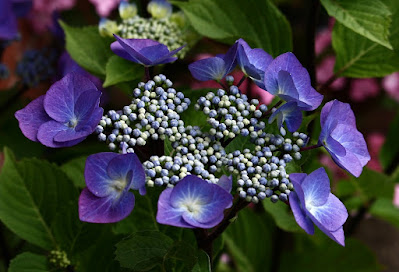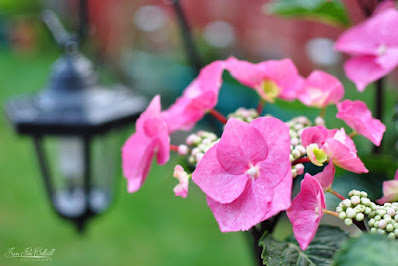Hydrangea macrophylla ZORRO - ZORRO Hydrangea is characterized by prominent dark purple-brown stems, dark green foliage and blue to pink flowers.
Hydrangea macrophylla ZORRO also called as ZORRO Hydrangea, is a cultivar in the genus Hydrangea. This cultivar was discovered by André van Zoest B.V. at a nursery in Reeuwijk, The Netherlands in October 2000.
DESCRIPTION OF HYDRANGEA MACROPHYLLA ZORRO - ZORRO HYDRANGEA
Hydrangea macrophylla ZORRO is a whole plant which had developed from a naturally occurring branch mutation of the variety Hydrangea macrophylla ‘Blaumeise’. Asexual propagation of softwood cuttings has determined that the characteristics of the plant are fixed and are reproduced true to type in successive generations.
It is a dwarf bushy perennial shrub which reaching 42.5 cm tall and 42.5 cm spread in 18 months with compact, upright, inverted triangular plant habit. The stems are rounded, 28.3 cm long, smooth, glossy, dark purple brown in color. The leaves are deciduous, dark green in color, opposite, broad ovate, 11 cm long by 8.4 cm wide, abruptly acute apex, broadly attenuate base, serrate margin.
ZORRO Hydrangea blooms in summer from the flattened compound corymb with an average of 185 fertile flowers, and 10 sterile flowers. The flowers will be pink in alkaline soil and blue in acidic soil. Pink hydrangea flowers can be changed to blue by acidifying soil and maintaining the pH in the 5.0 to 5.5 range. Adjusting a soil’s pH will need to be done annually in order to achieve and maintain proper results. The results from a soil pH test kit will determine existing pH levels and the need to add lime or sulfur in order to adjust the soil accordingly. Tap water may alter test results; therefore, it is important to use deionized water with a soil testing kit. Sulfur should be added in order to lower a soil’s pH. Lime should be added in order to raise a soil’s pH. Elemental sulfur, also called flowers of sulfur, or iron sulfate are better alternatives to using aluminum sulfate because aluminum can reach toxic levels in the soil. While aluminum is a key element to lower a soil’s acidity and change the color of hydrangea flowers, it can also become toxic at high levels.
HYDRANGEA MACROPHYLLA ZORRO - ZORRO HYDRANGEA CARE AND CULTURE
Cultural information should only be used as a guide, and should be to be adapted to suit you. Your physical location; where you grow your plants, how much time you have to devote to their care, and many other factors, will need to be taken into account. Only then can you decide on the cultural methods that best suit you and your plants.
Light:
Hydrangea macrophylla ZORRO love the warm morning sun, but they dislike the heat of the afternoon. The best place for the plant is in a sheltered location with sunny mornings and shady afternoons. Avoid planting directly underneath trees, which can lead to competition for water and nutrients. High winds can rip and damage leaves and destroy the flowers. Although they can be successfully grown in full shade, they will not bloom well.
Temperature:
ZORRO Hydrangea prefers a cool location, from 18° to 24°C. The plant may suffer from considerable branch dieback during the cold months and will benefit from winter protection. Winter protection can be provided by constructing a wire framework around the plant and filling the space with shredded leaves to a depth of approximately 10-12” for insulation. Cold winters and late spring frosts can often kill flower buds, preventing plants from blooming in the spring. When unexpected cold weather is predicted in late spring or early summer after winter protection has been removed, it may be necessary to cover tender plant with cloth, burlap, or heavy paper to protect flower buds. Plastic should never be used as winter protection because it may damage tender plant tissue.
Substrate, growing media:
Hydrangea macrophylla ZORRO are best planted in well-drained, moist soil, preferably a fertile sandy or silt loam with greater than 1% organic matter. The plant can also grow in clay soils with proper water management. When grown in container, the plant needs a well-drained substrate with sphagnum peat moss to increase substrate water holding capacity, and perlite or pumice to maintain adequate air space.
Humidity and Watering:
ZORRO Hydrangea prefers consistent moisture but dislike wet feet. The plant should be watered thoroughly at least 3 times a week. Always water the plant all the way around the container, not just in one place. Water should come out the bottom of the pot. Never let it sit in water which will cause the roots to rot away. Mulch to help conserve moisture and cool the root system. A two- to three-inch layer of mulch will help to conserve moisture.
Fertilizer:
Fertilizing is generally not recommended unless a nutrient deficiency is observed. The plants may need little fertilizer in rich soil with organic matter applied yearly. Avoid using too much nitrogen, too much nitrogen can produce excessive green growth at the expense of flowers. If you do fertilize, do a little research to find out exactly what your plant might need, and always apply as directed and read and follow all label directions.
Pruning:
The plant bloom on last year’s woody stems. Late heavy pruning will remove your blooms for the year! Instead, prune out one half to all of the older stems (they have side branches) at ground level in June and July when you are cutting flowers for arrangements or drying. This pruning method will allow more light and air circulation within your plant for disease control, while at the same time reducing size and increasing flower cluster size. Prune in late winter if you missed the opportunity in summer. Remove dead branches or frost-damaged leaves and stems as soon as you notice them. Wait to prune new plants until they are 5-6 years old.
Propagation:
Hydrangea macrophylla ZORRO is mainly propagated by softwood cuttings. The cutting should be taken from non-flowering green woody stems and cut at the base. Each cutting should have at least one leaf node or terminal bud. It is important not to damage the buds while obtaining the cuttings. Dip your cutting into your rooting hormone, then place into the sterile media that should consist of one part peat and one part medium to fine grade perlite, vermiculite, or sand. Spray the plant until wet but dont over water it. Watering is important for the first week, three times a day is recommended for the first week when top soil feels dry. Dont place the plant in direct sunlight or wind. After a few weeks you should see growth from your cuttings.
Pests and diseases:
BBBBBBB are almost trouble-free. However, certain pests and diseases can attack. The most common time for them to do so is in the summer months. They most commonly suffer from powdery mildew, aphids, spider mites, yellow leaves and leaf spots. All of these are common to spot and treat, providing you catch the disease or pest early.















COMMENTS